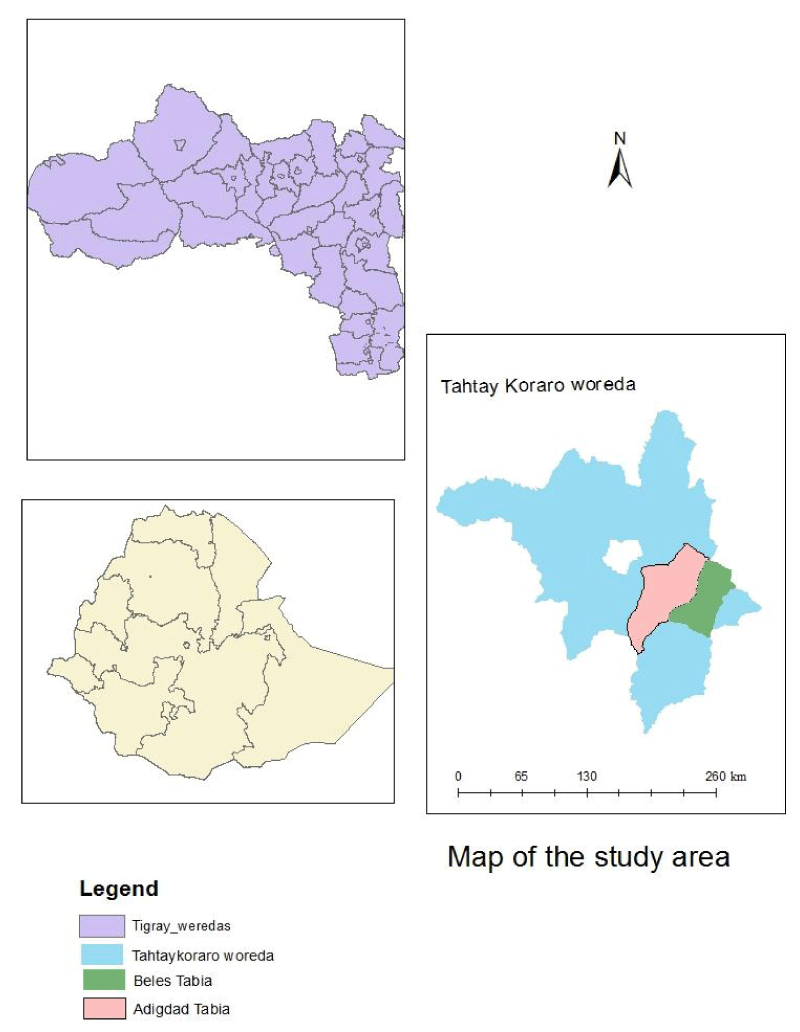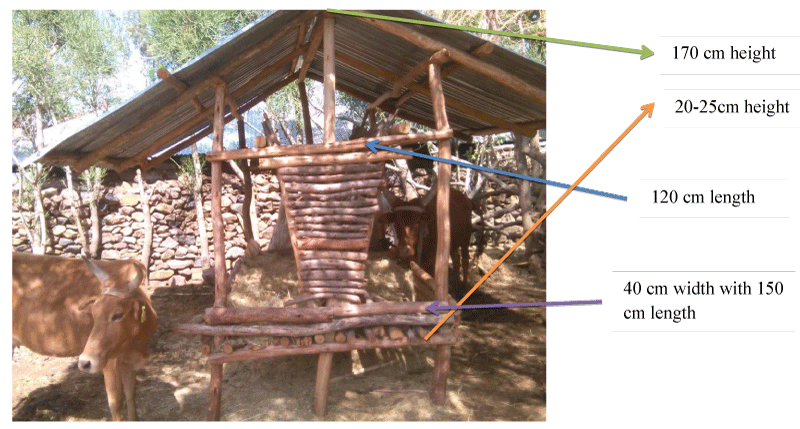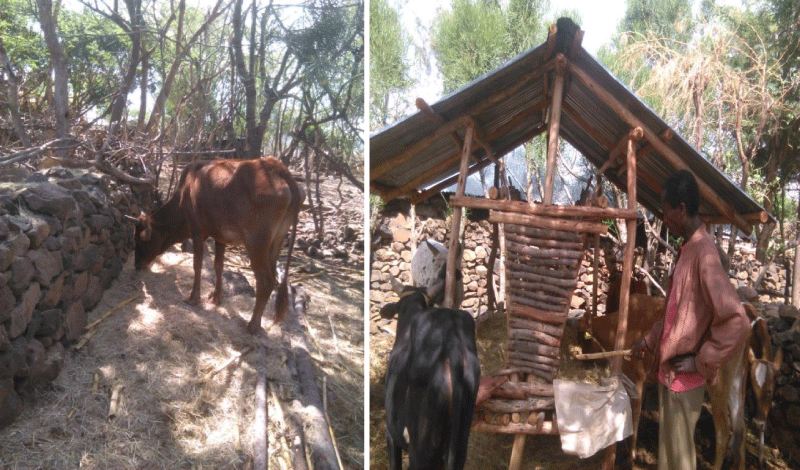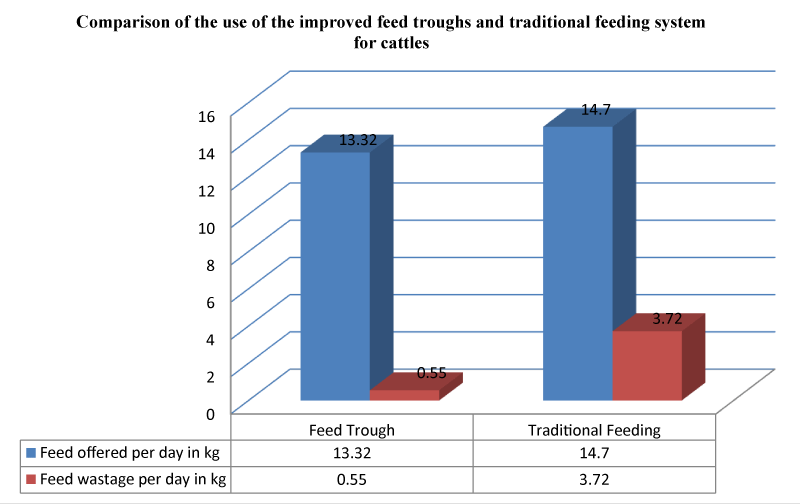International Journal of Agricultural Science and Food Technology
Comparative advantage of improved feed trough and the traditional feeding material for efficient utilization of crop residue at small-scale farmers in Northwestern Tigray, Ethiopia
Teklemariam Abadi1*, Kibrom Gebremedhin2, Desale Gebretsadik1 and Daniel Desta1
2Tigray Agricultural Research Institute, Shire-Maitsebri Agricultural Research Center, Department of Livestock Production, Ethiopia
Cite this as
Abadi T, Gebremedhin K, Gebretsadik D, Desta D (2023) Comparative advantage of improved feed trough and the traditional feeding material for efficient utilization of crop residue at small-scale farmers in Northwestern Tigray, Ethiopia. Int J Agric Sc Food Technol 9(2): 021-025. DOI: 10.17352/2455-815X.000186Copyright License
© 2023 Abadi T, et al. This is an open-access article distributed under the terms of the Creative Commons Attribution License, which permits unrestricted use, distribution, and reproduction in any medium, provided the original author and source are credited.The study was conducted to reduce the high feed wastage by practicing the improved feed trough in the study area. The trail was conducted at Tahtay Koraro district Northwestern zone of Tigray, Ethiopia. Improved feed trough was constructed on a total of 20 interested farmers. Both quantitative and qualitative data were collected andanalyzed using descriptive statistics. The result showed that the improved feed troughs reduced feed waste significantly in the study area. That is 4.13% and 25% feed loss respectively in improved and traditional feed troughs. The result from the farmers perception also shows that, the farmers were preferred the technology in its less feed wastage, reduces feed contamination, gives an opportunity for persons to do other task than keeping animals, comfortable for the animals, reduces feed competition among the animals; and protects the feed from rain and sun. But farmers are less preferred the technology in its cost for its construction. Therefore, based on the result it is recommended that the technology has to be popularized and promoted to the large number of the farmers of the area for the efficient crop residue utilization.
Introduction
Shortage of feed supply is the main constraint limiting productivity of livestock in Ethiopia [1]. The Tigray regions have crop-livestock mixed farming system. Most of the area in the region is dominated by hillsides and sloppy areas which lead to fragmented and farm land shortages, then the small-scale farmers are forced to cover this small farm land using crops to full fill their food shortage. The uncontrolled grazing system which aggravated soil and grassland degradation, poor feed conservation practices, lack of knowledge on appropriate feed and feeding practices, and inadequate data on estimates of the proportion/number of animals kept within specific production systems constraint the efficient use of available feed resources [2]. Due to the above challenges livestock of the rural areas are characterized by feed shortage in quality and quantity.
In the mixed crop livestock farming systems of the Ethiopian, crop residues provide on average about 50% of the total feed source for ruminant livestock. The contributions of crop residues reach up to 80% during the dry seasons of the year [3]. However, farmers are also observed practicing poor management and low efficient utilization of the crop residue that expose to large wastage during feeding their livestock. In most part of the country, they put the feed on the ground, leading to very high wastage.
Therefore to alleviate the problem, complementary efficient feed utilization system and feeding management options need to be developed. To reduce feed wastage on farms using improved feed troughs is important. The study of ILRI [4] indicted that; as troughs reduced feed wastage by 25% and reduces feed costs. Reducing wastage decreases the amount of work women and children had to do in several ways: they had to collect less fodder from the forest, they no longer had to rearrange fodder around the animals to stop them from trampling on it and soiling it, and there was less waste fodder to clear out from the cattle sheds. Clean fodder, free of urine and dung, reduced the risk of infections for the animals. More efficient management and utilization of available feed resources could help to improve livestock production in a sustainable manner. Hence feeding their animals using feed trough can be help the small-scale farmers to reduce wastage of crop residue biomass during utilization could enable to feed more animals and increase their income through improving their animal productivity. Therefore, this is initiated to demonstrate this improved feeding practice to create awareness in the study areas.
Objectives
✔ To demonstrate feed trough in the study area
✔ To reduce the feed loss using feed trough for feeding cattle
Materials and methods
Description of the study area
Demonstration of improved feed trough was conducted in Tahtay Koraro district of Northwestern Tigray. The district is located 1,087 km from Addis Ababa, 304 km west of Mekelle and it is bordered byAsgede TsimblaWoredain the South, MedebayZanaWoreda in the North and East and Laelay Adyabo Woredain theWest. It is geographically locatedat 13.9 oC - 14.27 oC Northing and 38.05 oC - 38.45 oC Easting. Agro ecologically the district has77% midland and 23% lowland. The Woreda has a mean annual rainfall of 750 mm, mean annual temperature of 27 oC and with a mid-altitude of 1953 meters above sea level [5]. The major crop of the Woreda includes teff, maize, field pea and chickpea; and the horticultural crops like banana, mango and vegetables like hot pepper and tomato and cattle, goat, sheep and poultry are the dominant livestock in the study area.
Sampling system and implementation procedure
Two ‘Tabias’ (Belles and Adigdad) were selected purposively for the study from Tahtay Koraro district based on their accessibility. 10 farmers from each of the two ‘Tabias’ a total of 20 small-scale farmers were selected based in their interest to introduce the technology and that keep dairy cattle and willing to provide locally available materials and labour for the trough construction. Training on importance and applicability of the technology were given for the participant farmers, DAs and Woreda experts. Participant farmers were provided the local material such as land for construction,wood tree and labor.
The double faced feed trough was constructed to serve 3 - 6 animals at a time. It was constructed 40 cm height above ground and 50 - 80 centimeter width, 150 cm length, 20 - 25 centimeter height from the floor of the trough and 170 cm height from the floor of the trough to the roof (Figures 1-3). The trough has roofed shade protection from rain and sun and has straw storage within it. The AGP (Agricultural Growth Program) was provided industrial materials like corrugated iron sheet (6 iron sheet/feed troughs), nails and eucalyptus for constructing and carpenter labor cost. Each farmers were agreed to offer Tef straw for their cattle. Then by hiring two enumerators weighing of the daily provided and wasted feed were conducted for the fourteen consecutive days which is seven days on the improved feed trough and seven days on the traditional feeding. On average four cattle were used to feed on the trails.
Methods of data collection and analysis
After the 7 days feeding their animals on each of the traditional and improved feed troughs; quantitative data such as the amount of feed offered and the daily feed wasted and the cost return were recorded and the qualitative data farmers perception were collected using checklist. For the qualitative data the farmers were asked to respond their point of view on the introduced feed trough technology compared to the traditional feeding using Likert scale questions. The response for the questions could be strongly disagree, disagree, no change, agree or strongly agree. Attributes such as less feed wastage, protects from sunlight, rain & wind damage, serves as shed for the animals, gives an opportunity for persons to do other tasks than keeping them, reduces feed contamination by mud, urine & feces, comfortable for the animal to eat, decrease feed competition among different groups of animals, needs less frequent of replenish feed, easy of the design to construct by farmers and cost effective were used. Then the collected data were analysed using descriptive statistics.
The feed wastage comparisons were undertaken between the improved feed trough and the traditional feeding system. The result indicates that the use of the traditional and improved feed troughs showed that the improved feed troughs reduced feed wasted significantly in the study area. Which is value of feed wastage from Tef straw given for animals per day was significantly different between the improved and traditional feed troughs. That is 4.13% and 25.3% feed loss were recorded respectively in improved and traditional feed troughs (Figure 4). Similar to this study the finding of [6] also indicate that the traditional feeding systems are characterized by a lot of feed waste which is up to 36% as compared to the improved feed trough below 1% feed loss. The report by [7] at Southern Tigray also reveals that higher feed wastage was occurred at traditional feed trough than the improved feed trough. Hence, the result indicates that for the efficient feed utilization and reduced wastage introduction of the improved feed trough is valuable.
Farmers perception towards the new technology
Insight of farmers towards the newly introduced improved feed trough was assessed compared to the traditional feeding system. All of the respondents agreed that with the feed trough there is less feed wastage and reduces feed contamination. Farmers was also agreed that as the improved feed trough is giving an opportunity for persons to do other tasks than keeping animals, comfortable to animals to eat, decrease feed competition among different groups of animals and protects the feed from sunlight and rain damage. Similar to this, farmers in northern Ghana also agreed that the improved feed trough has less feed waste, reduces feed contamination and comfortable for the animals to eat [6]. But the farmers were dis agreed that in easiness of the design and cost for constructing of the improved feed trough compared the traditional feed (Table 1). The finding of [7] also noted that all farmers has agreed that high feed wastage were observed in traditional feeding system while, more of the farmers responded that feed trough needs high cost for constructing the feed trough compared to traditional feeding system. Generally the participating farmers in the trail as well as the non-participant farmers were highly enthusiastic and interesting with the technology. The farmers who were not involved in demonstrating the technology was requested for the introduction and promotion of the improved feed trough.
Comparative analysis
According to the farmers feed provision practice inthe study area, the annual feed requirements was 5365.5 kg which was offered to 4 - 6 cattle; though the actual annual feed requirement is 6935 kg based on [8] and [9] calculation for TLU and feed requirements. From the 7 days feeding trail result, the annual feed wastage was 1357.8 kg and 200.75 kg at traditional and improved feed trough feeding system, respectively. The wasted feed 1357.8 kg in traditional and 200.75 kg from the improved feed trough could serve to feed for 92.36 days and 15.07 days, respectively to an average animal of 4.35 or 3.04 TLU.
The total cost in improved feed trough was 3612.00 Birr and total revenue was 25823.75 Birr with a net return of 22211.75 Birr. While the total cost for traditional feeding was 0.00 with a total revenue and net return of 20038.5 (Table 2). The cost for improved feed trough construction could covered within 227.88 days (7.59 month) feed loss of the traditional feeding system. This indicates feeding animals using the improved feed trough is highly economical than using the traditional feeding system. In order to make the improved feed trough more easy and profitable the farming community could construct the feed trough using local materials like trees and plastic or grass as thatch for the roof, except the cost for the nails.
Conclusion and recommendations
Based on the demonstration trail the improved feed trough has reduced feed wastage significantly in all the study areas. The amount of feed wastage at improved feed trough and traditional fed trough was 4.13% and 25%, respectively. Farmers spent less time in feeding their animals when used the improved feed trough. All of the respondents were preferred the improved feed trough technology in its less feed wastage, reduces feed contamination, gives an opportunity for persons to do other tasks than keeping animals, comfortable to animals to eat, decrease feed competition among animals and protects the feed from sunlight and rain damage. But the technology was less preferred by the participants in its cost for construction; however this cost could improve by encouraging the farmers to use the local materials such as locally available trees and plastic or grass as thatch for the roof. Hence, based on the finding of the study it is recommended that the hosted district office of agriculture and rural development, other governmental and non-governmental organization should involve in promoting the improved feeding system to large farming community of the study area.
The authors would like to thanks to Tigray Agricultural Research Institute, Shire-Maitsebri Agricultural Research Center and for Agricultural Growth Program (AGP II) for its financial support. The authors would also like to thanks for all researchers, development agents, district experts and for all of the farmers who was participated in conducting the trials.
- Tolera A, Yami A, Alemu D. Livestock Feed Resources in Ethiopia: Challenges, Opportunities and the Need for Transformation. Ethiopian Animal Feed Industry Association. 2012.
- FAO and IGAD (Food and Agriculture Organization of the United Nations and the Intergovernmental Authority on Development). East Africa Animal Feed Action Plan. Rome. 2019.
- Adugna T. Feed resources for producing export quality meat and livestock in Ethiopia (Examples from selected Weredas in Oromia and SNNP regional states. 2007.
- ILRI (International Livestock Research Institute). Improved feed troughs to reduce wastage Feed Intervention TechSheet 31, ilri.org/techfit. 2015. https://pdfs.semanticscholar.org/512c/a9f1a3b1f3f12eb062be291b2b068d12e653.pdf.
- OoARD (Office of Agriculture and Rural Development of TahtayKoraro. 2018. Unpublished annual report.
- Ayantunde Augustine, Sadat Salifu, Shaibu Mohammed, and Solomon Konlan. Efficient feed utilization through improved feed troughs for small ruminants in northern Ghana, International Institute of Tropical Agriculture. 2019. www.africa-rising.net.
- Tesfay Atsbha, Solomon Wayu, Nguse Gebretsadkan, Hagos Kidane and Kiflom Degf. Demonstration of Improved Feed Trough for Efficient Utilization of Crop Residue: The Case of Southern Zone of Tigray Region, Ethiopia, International Journal of Agriculture and Bioscience. 2019. www.ijagbio.com.
- FAO. 2018c. Resilience Good Practices. Improving pasture management in arid and semi-arid lands in the Horn of Africa through Pastoralist Field Schools. http://www.fao.org/3/I8855EN/i8855en.pdf.
- Jankeet. Tropical Livestock Units are livestock numbers converted to a common unit. 1982. https://pdfs.semanticscholar.org/512c/a9f1a3b1f3f12eb062be291b2b068d12e653.pdf.
Article Alerts
Subscribe to our articles alerts and stay tuned.
 This work is licensed under a Creative Commons Attribution 4.0 International License.
This work is licensed under a Creative Commons Attribution 4.0 International License.






 Save to Mendeley
Save to Mendeley
